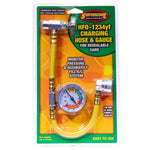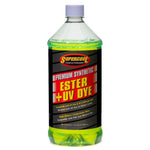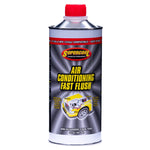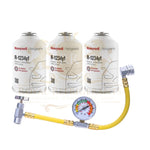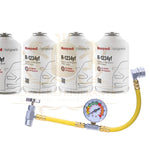You have no items in your shopping cart.
Everything You Need to Know About Car Refrigerant for HVAC and Automotive Applications
When the summer heat hits, the cool breeze from your car’s air conditioner feels like magic. But behind that comfort is a crucial element — the car refrigerant. It’s the invisible fluid that absorbs heat, circulates through your A/C system, and makes cooling possible.
In this blog, we’ll explore everything you need to know about car refrigerants — from how they work and what types exist, to their environmental impact and maintenance tips. We’ll also look at how refrigerants are used in both automotive and HVAC applications.
What Is Car Refrigerant?
A car refrigerant is a specialized chemical compound used in your vehicle’s air conditioning system. Its main job is to absorb heat from inside the cabin and release it outside, leaving the interior cool and comfortable.
In simple words: Refrigerant = Cooling Agent.
It works in a closed-loop system, meaning it circulates continuously through your A/C components — compressor, condenser, expansion valve, and evaporator — without ever being “used up,” unless there’s a leak.
How Does Car Refrigerant Work?
Every air conditioning system follows a basic refrigeration cycle, whether in your car or a home HVAC unit:
Compression:
The refrigerant gas is pressurized by the compressor, increasing its temperature.
Condensation:
The hot gas passes through the condenser, where it cools down and turns into a liquid.
Expansion:
The liquid refrigerant expands through the expansion valve, dropping its pressure and temperature.
Evaporation:
The refrigerant absorbs heat from the car’s cabin air through the evaporator, cooling the air before it’s blown back inside.
This continuous process keeps your car’s interior pleasantly cool — even on scorching days.

Types of Car Refrigerants
Over the years, the automotive industry has used different refrigerants based on efficiency, safety, and environmental regulations.
| Refrigerant Type | Used In | Notes |
|---|---|---|
| R-12 (Freon-12) | Cars before 1995 | Chlorofluorocarbon (CFC) – phased out due to ozone damage |
| R-134a | Cars from 1995–2016 | Hydrofluorocarbon (HFC) – widely used, moderate global warming potential |
| R-1234yf | Cars from 2017–present | Hydrofluoroolefin (HFO) – eco-friendly, low GWP |
| R-744 (CO₂) | High-end/luxury cars | Natural refrigerant, energy-efficient, sustainable |
💡 Pro Tip: Always check your vehicle manual before refilling refrigerant. Using the wrong type can damage the compressor and void your warranty.
Car Refrigerant vs. HVAC Refrigerant
While both systems use similar principles, the formulation and pressure levels differ:
| Category | Car A/C System | Home/Commercial HVAC |
|---|---|---|
| Common Types | R-134a, R-1234yf | R-22, R-410A, R-32 |
| Operating Pressure | Higher (due to compact system) | Lower, more stable |
| Environment | Mobile and vibration-prone | Stationary |
| Servicing | Requires vehicle-specific tools | Standard HVAC tools |
So, while both rely on refrigerants, the systems are tuned differently to meet their unique operating needs.
Signs Your Car Might Be Low on Refrigerant
If your car’s A/C isn’t cooling properly, it might be due to a refrigerant leak or low levels. Watch for these signs:
-
Warm or weak airflow from vents
-
Hissing or clicking sounds when A/C is on
-
Visible oily residue near A/C hoses or compressor
-
The compressor not engaging
-
Foggy or humid cabin air
👉 Don’t ignore these symptoms. Low refrigerant can cause your compressor to overheat and fail — a costly repair.
Environmental Concerns and Regulations
Older refrigerants like R-12 and R-22 were found to harm the ozone layer, leading to international phaseouts (like the Montreal Protocol). Even newer ones like R-134a are being replaced due to their global warming potential.
Modern alternatives such as R-1234yf and R-744 (CO₂) are much safer and meet environmental standards set by the EPA and European Union.
Eco-Friendly Refrigerants: The Future of Cooling
The cooling industry — both automotive and HVAC — is moving toward sustainable, low-GWP refrigerants:
-
R-1234yf for most new cars
-
R-744 (CO₂) for advanced systems
-
R-32, R-454B, and R-290 (propane) for modern HVAC units
These alternatives are designed to minimize environmental harm while improving energy efficiency.
Safety and Maintenance Tips
To keep your A/C system performing efficiently:
-
Inspect annually — especially before summer.
-
Avoid DIY recharges unless trained.
-
Check for leaks and fix them immediately.
-
Use only approved refrigerants recommended by your car’s manufacturer.
-
Recycle or dispose of old refrigerants safely.
Conclusion
Car refrigerant is more than just “A/C gas” — it’s the heart of your vehicle’s cooling system. Understanding its function, types, and maintenance needs helps you keep your car comfortable, efficient, and eco-friendly.
As technology advances, we’re seeing a major shift toward environmentally responsible refrigerants, ensuring both your comfort and a cleaner planet.
 English
English

